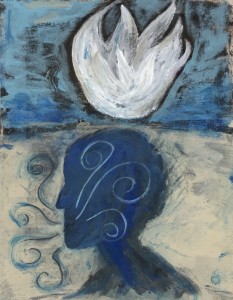Never underestimate the healing power of your breath

In a late July issue of The Journal of the American Medical Association, Dr. Elizabeth Levin shared a transformative journey, both personal and professional, that speaks directly to the heart of the yogi.
In her fourth year of medical school, in a subinternship at Cook County Hospital in Chicago, Dr. Levin worked with a 36-year-old woman, a mom, with metastatic breast cancer. On the final day of her rotation, Dr. Levin visited the patient for the last time. During their conversation, the patient talked about her plans for her young son’s care after her death. As the women spoke, Dr. Levin began to cry. “I could not stop myself,” she wrote in her JAMA article, “Learning to Breath.”
Dr. Levin continued, “As I continued to cry, she cried as well. I knew she was upset with herself, and me, because she felt crying was a sign of weakness. Despite my best efforts, I cried and, in the process, upset my patient even more.”
As part of her medical training, Dr. Levin was taking a course in mindfulness-based stress  reduction (MBSR). On the same day as that painful goodbye, the MBSR class focused on coping with stress encountered during clinical practice. During a meditation segment, the instructor asked the medical students to talk about a difficult time they’d had with a patient. While her classmates shared their experiences, Dr. Levin struggled to relax and breathe. She was losing her focus, her presence in the moment, and she dreaded sharing her experience with her colleagues.
reduction (MBSR). On the same day as that painful goodbye, the MBSR class focused on coping with stress encountered during clinical practice. During a meditation segment, the instructor asked the medical students to talk about a difficult time they’d had with a patient. While her classmates shared their experiences, Dr. Levin struggled to relax and breathe. She was losing her focus, her presence in the moment, and she dreaded sharing her experience with her colleagues.
She writes, “ . . . the time came for my turn and I began my story of the day. Crying, I felt the pit in my stomach. I became aware of my breath, the short inspirations and the tightness in my throat. But I felt relief as I told my story to the group.”
Over the following weeks, the doctors-in-training observed and documented how challenging patient interactions affected their own bodies and breath. Dr. Levin noticed that she often held her breath when confronted with sadness or suffering. With practice, she learned to stay present and not be swept away by the rising tide of emotion during stressful encounters.
A year later, working as a resident in internal medicine, Dr. Levin used the tools of mindfulness, particularly deep breathing, to help support another critically ill patient and her family. She remained compassionate, but in control. She wrote that this pivotal experience, and others that followed, would not have been possible had she not learned how to breathe.
I came across Dr. Levin’s piece while looking for articles about yoga research, and was touched by her experiences and her honesty. Her article reminds us that yoga is not only practiced on the mat, or in a pose. This young doctor is practicing yoga when she uses her breath to steady herself in difficult situations; she’s using yoga when she shows her patients compassion.
Never underestimate the healing power of your breath. As I regularly tell students, observe your breath. Observe it when you rest and as you move. Let your breath calm you, cool you, warm you, serve you. Breathe, then breathe again, before you scream harsh words at a loved one, when someone cuts you off on the road, when you’re pissed at your boss, when you feel like you’re losing your mind. And cherish your breath, because it keeps you strong and alive.
To learn simple yogic breathing techniques, click on the Pranayama tab.
Lotus Mind illustration: © Antaratma Images | Dreamstime.com; Your heart in my hands photo: © Mitar Gavric | Dreamstime.com




